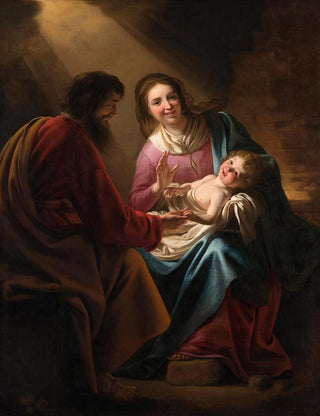Art print | The Holy Family - Gerard van Honthorst


View from behind

Frame (optional)
Art print La Sainte Famille - Gerard van Honthorst – Engaging Introduction
In the captivating world of baroque art, "La Sainte Famille" by Gerard van Honthorst stands out for its emotional depth and dramatic lighting. This piece, created in the early 17th century, embodies the very essence of Christian spirituality while offering a glimpse into the innovative techniques of the period. The scene, imbued with tenderness and devotion, transports us to an intimate moment in the life of the Holy Family, where every detail seems charged with meaning and emotion. The work invites viewers to contemplate the beauty of motherhood and the strength of family bonds, all wrapped in an atmosphere of serenity.
Style and uniqueness of the work
Gerard van Honthorst's style is characterized by a masterful use of light, which gives his compositions an almost theatrical dimension. In "La Sainte Famille," the artist exploits chiaroscuro, a technique that creates a striking contrast between illuminated areas and shadows, thus emphasizing the presence of the characters. The faces, filled with palpable softness, are illuminated in a way that highlights the emotions they convey. The warm, rich colors, typical of the baroque, enhance the scene's depth, while the flowing drapery of the clothing adds a captivating visual dynamism. Every element of this work is carefully orchestrated to evoke an atmosphere of peace and protection, making this representation a timeless masterpiece.
The artist and his influence
Gerard van Honthorst, born in Utrecht in 1590, established himself as one of the great masters of Dutch baroque. A pupil of the illustrious Caravaggio, he integrated chiaroscuro principles into his own creations, while developing a distinctive style that is uniquely his own. Honthorst was particularly influenced by his travels to Rome, where he was exposed to the richness and diversity of the artistic currents of the time. His ability to capture moments of everyday life, blending realism and spirituality, left a lasting mark on European art. By exploring religious themes with a humanist approach, Honth

Matte finish

View from behind

Frame (optional)
Art print La Sainte Famille - Gerard van Honthorst – Engaging Introduction
In the captivating world of baroque art, "La Sainte Famille" by Gerard van Honthorst stands out for its emotional depth and dramatic lighting. This piece, created in the early 17th century, embodies the very essence of Christian spirituality while offering a glimpse into the innovative techniques of the period. The scene, imbued with tenderness and devotion, transports us to an intimate moment in the life of the Holy Family, where every detail seems charged with meaning and emotion. The work invites viewers to contemplate the beauty of motherhood and the strength of family bonds, all wrapped in an atmosphere of serenity.
Style and uniqueness of the work
Gerard van Honthorst's style is characterized by a masterful use of light, which gives his compositions an almost theatrical dimension. In "La Sainte Famille," the artist exploits chiaroscuro, a technique that creates a striking contrast between illuminated areas and shadows, thus emphasizing the presence of the characters. The faces, filled with palpable softness, are illuminated in a way that highlights the emotions they convey. The warm, rich colors, typical of the baroque, enhance the scene's depth, while the flowing drapery of the clothing adds a captivating visual dynamism. Every element of this work is carefully orchestrated to evoke an atmosphere of peace and protection, making this representation a timeless masterpiece.
The artist and his influence
Gerard van Honthorst, born in Utrecht in 1590, established himself as one of the great masters of Dutch baroque. A pupil of the illustrious Caravaggio, he integrated chiaroscuro principles into his own creations, while developing a distinctive style that is uniquely his own. Honthorst was particularly influenced by his travels to Rome, where he was exposed to the richness and diversity of the artistic currents of the time. His ability to capture moments of everyday life, blending realism and spirituality, left a lasting mark on European art. By exploring religious themes with a humanist approach, Honth






